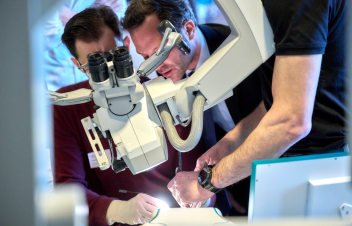Unlocking Career Success: The Benefits of Simulator Training
- surgeonslab1
- Jul 12, 2024
- 3 min read
Simulator training in neurosurgery helps surgeons practice and improve their skills in a safe environment by using high-tech tools that mimic real surgical procedures. This article looks at how simulator training has developed over time, its uses, and the advantages simulators training opportunities offer in neurosurgery, especially in simulations for aneurysm clipping and scenario-based learning.

The Evolution of Simulator Training in Neurosurgery
In the past, neurosurgical training mostly involved trainees watching and slowly gaining more hands-on practice under supervision. Although this method worked, it meant trainees could only be involved in a few cases and could sometimes put patients at risk as they learned.
The use of simulation in medical education brought about a big change in how training is done. Originally used in areas such as aviation, simulation methods were later used in medical training in the late 20th century. At first, medical simulators were simple and concentrated on specific skills rather than intricate procedures.
Thanks to technological progress, we now have amazing simulations for neurosurgery. By combining computer graphics, virtual reality (VR), and haptic feedback systems, we can create very realistic training settings. These advancements help us practice complex neurosurgical procedures with more precision than ever before.
Simulators Training Opportunities
Modern neurosurgical simulators come in various forms, each offering unique training opportunities:
Virtual Reality Simulators: These interactive systems create virtual environments that mimic surgical situations. They also include touch feedback tools to imitate the feeling of using surgical instruments.
3D-Printed Models: Physical models of body parts made from images of a specific patient let you practice using real surgical tools.
Mixed-Reality Simulators: These blend virtual and augmented reality with physical models to provide a mix of training experiences.
Simulation training has become more readily accessible in the past few years. Numerous neurosurgical residency programs currently incorporate simulator training into their curricula. Training programs and conventions also provide hands-on training sessions, allowing professionals to explore innovative methods and advancements.
Simulation is very important for medical education. Many professional organizations now see simulator-based training as a valuable part of ongoing skill development and evaluation for neurosurgeons.
Aneurysm Clipping Simulation
Performing an aneurysm clipping procedure requires exceptional spatial awareness, proficient hands, and strong decision-making skills. Utilizing simulation-based training is an effective method to rehearse this procedure and avoid significant errors. A standard aneurysm clipping simulation would generally unfold in the following manner:
Pre-operative Planning: Trainees review simulated patient data, including medical history and imaging studies.
Approach Selection: Trainees select a suitable surgical approach based on the aneurysm's location and characteristics.
Craniotomy Simulation: Practice cutting into the skull and moving through the brain to find the aneurysm.
Aneurysm Exposure: Thoroughly investigate nearby structures to completely reveal the aneurysm.
Clip Placement: Select and apply appropriate clips to occlude the aneurysm while preserving blood flow to normal vessels.
Complication Management: Respond to simulated complications such as intraoperative rupture or clip slippage.
Recent improvements in haptic technology make these simulations feel more real. New systems can mimic the touch of different tissues and the feel of blood vessels. They even give instant feedback on how well the trainee is doing.
Benefits of Simulator Training
There are many important benefits to using simulator training in neurosurgery.
Enhanced Technical Proficiency: Repeated training with simulators can help surgeons hone their eye-hand coordination, tool control, and overall surgical abilities.
Improved Decision-Making: Scenario-driven simulators help surgeons learn how to make major choices under pressure, improving their ability to resolve tricky issues in the operating room.
Procedural Planning: Simulators help surgeons learn multiple techniques, increasing their ability to arrange therapies properly.
Error Reduction: Simulators help surgeons practice while growing from their failures in a safe setting, leading to reduced mistakes during surgical procedures.
Improved Patient Outcomes: Improving skills, making smarter choices, and inhibiting mistakes are all ways to keep patients safe and produce better outcomes.
In A Nutshell
Simulator training is increasingly important in today's field of neurosurgery. It offers great chances to improve skills, practice without risks, and keep learning. Whether it's mastering tricky tasks like aneurysm clipping or neurological aneurysm scenarios guidance, simulators are changing how neurosurgeons get ready for their work challenges.
As technology evolves, simulations will play an increasing part in neurosurgical training. The neurosurgical community can boost patient safety and end results by incorporating these advances into education courses, which can also open up fresh prospects for neurosurgeons of any level of expertise.
Neurosurgery advances rely on both surgeon skills and modern equipment that augment their abilities. Simulator training will definitely be critical in planning the next wave of neurosurgical professionals.







